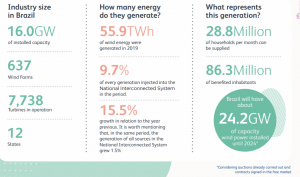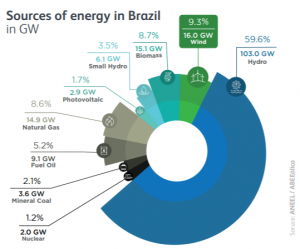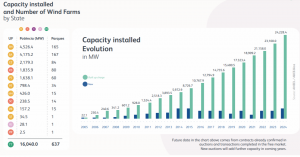Global Wind Day: Brazil completes 16 GW of wind power installed capacity
he wind power sector celebrates, on this Global Wind Day, June 15, the mark of 16 GW of installed capacity of wind energy, with 637 wind farms and more than 7,700 wind turbines. This infrastructure generated 55.9 TWh of energy last year, representing an increase of 15% in relation to the generation of the previous year. The energy generated, on a monthly average, is enough to supply 28.8 million homes per month, which means a population of around 86 million people. Since last year, wind energy has been the second source of the Brazilian electric matrix.



On average, last year, 9.7% of the entire generation injected into the National Interconnected System came from wind farms, and they have already supplied 17% of the country at record times in the months that are part of the period called “harvest of the winds ”. Last year, the wind industry invested R $ 13.6 billion in Brazil, according to Bloomberg New Energy Finance (BNEF). In 2020, Brazil rose one more position in the World Ranking of the GWEC (Global Wind Energy Council) reaching the seventh position. In 2012, we were in 15th position.


The efficient development of the wind industry in Brazil can be explained by the excellent quality of the Brazilian winds and also by the strong investment of companies that, in the last ten years, have built a national production chain to sustain the commitments assumed and the enormous growth potential of this source of energy in Brazil. Regarding the quality of the winds, it is important to mention that Brazil has a capacity factor above the world average. Last year, for example, the average global capacity factor was 34%, while in Brazil it was 42.7%, with an average month reaching 59% during the wind harvest.
“All of these positive numbers show not only a consolidated sector, but also demonstrate that wind energy has a promising future in Brazil. The energy produced by the winds is renewable; does not pollute; it has a very low environmental impact; contributes to Brazil’s compliance with the Climate Agreement; does not emit CO2 in its operation; it has one of the best cost benefits in the energy tariff; allows landowners where the wind turbines are located to have other activities on the same land; generates income through the payment of leases; promotes the fixation of man in the field with sustainable development; it generates jobs that go from the factory to the most remote regions where the parks are located and encourage tourism by promoting regional development”, explains Elbia Gannoum, ABEEólica´s CEO.
Effects of the pandemic at auctions
By 2024, Brazil will have at least 24 GW of installed wind energy capacity. “We say ‘at least’, because that is the value considering only auctions already carried out and contracts signed in the free market. With new auctions, this number will be higher. And it is very important to consider the importance that the free market has been taking for the sector. In 2018 and 2019, for example, they were the first years in which contracting was greater in the free market than in the regulated market. Regarding new hires, I have received many questions about the impact of the pandemic on the sector. It is clear that there will be an impact, because the drop in demand was great and this should impact the next auctions in the regulated market, but I still think it is early to talk about numbers of this impact, because the free market moves fast and has grown a lot. This can make a lot of difference for wind farms. And, even in regulated auctions, we know that wind farms tend to play an important role due to their competitiveness and for what the PDE 2029 signals. Knowing that yes there will be an impact, it is good to wait a little longer, to study how the PDE review will come and especially analyze the movement of the free market”, analyzes Elbia Gannoum.
Economic recovery, post-pandemic and energy transition
GWEC (Global Wind Energy Council) launched, a few weeks ago, the document “Wind power a cornerstone of the global economic recovery”. In the manifesto, GWEC presents arguments about the power of investment from the wind power sector, with job creation and positive effects for communities and for technological development. In addition, GWEC presents actions that can be taken by governments to ensure that, in the “day after” of this pandemic, efforts to rebuild and resume the economy can take place in order to contribute to a more just and sustainable society.
“I consider this to be an essential discussion. The pandemic is opening humanity’s eyes even more to the urgent fight against global warming. And in this process, sources that do not emit greenhouse gases and have social, economic and environmental benefits, such as wind, are our best bet when the time comes for economic recovery. In the case of Brazil, the good news is that we have as one of its main comparative advantages in relation to a large majority of countries the fact that we have a great diversity of clean energies and, in the case of wind power, it still has the fact that Brazil has one of the best winds in the world, which means very competitive energy ”, explains Elbia.
“In the various virtual events in which I have participated, a question often arises and has to do with a concern that the pandemic could halt the energy transition or change its course. I do not believe this can happen. The history of development of renewable energies in the world, with falling costs and expansion of technology, leads us to the conclusion that the pandemic may even slow the speed of the energy transition in the short term, because there has been a huge drop in demand, but that there will be no change of course. Renewables are already cheaper in many markets and we will continue on the path of energy transition”, summarizes Elbia.
New materials
On this Global Wind Day, ABEEólica also publishes an update on Infovento, ABEEólica’s infographic that gathers the main data of the sector, in Portuguese and English versions.
The Association is also publishing today the Annual Wind Generation Bulletin, with consolidated data for 2019 and which can be consulted here in Portuguese. The English version will be published in the next few weeks.
About ABEEólica
ABEEólica gathers more than 100 companies from the entire production chain of the wind sector and its main objective is to work for the growth, consolidation and sustainability of this industry in Brazil.
Press
Selma Bellini
Fones: +55 11 3674-1117 / +55 11 97653-2917[:en]The wind power sector celebrates, on this Global Wind Day, June 15, the mark of 16 GW of installed capacity of wind energy, with 637 wind farms and more than 7,700 wind turbines. This infrastructure generated 55.9 TWh of energy last year, representing an increase of 15% in relation to the generation of the previous year. The energy generated, on a monthly average, is enough to supply 28.8 million homes per month, which means a population of around 86 million people. Since last year, wind energy has been the second source of the Brazilian electric matrix.



On average, last year, 9.7% of the entire generation injected into the National Interconnected System came from wind farms, and they have already supplied 17% of the country at record times in the months that are part of the period called “harvest of the winds ”. Last year, the wind industry invested R $ 13.6 billion in Brazil, according to Bloomberg New Energy Finance (BNEF). In 2020, Brazil rose one more position in the World Ranking of the GWEC (Global Wind Energy Council) reaching the seventh position. In 2012, we were in 15th position.


The efficient development of the wind industry in Brazil can be explained by the excellent quality of the Brazilian winds and also by the strong investment of companies that, in the last ten years, have built a national production chain to sustain the commitments assumed and the enormous growth potential of this source of energy in Brazil. Regarding the quality of the winds, it is important to mention that Brazil has a capacity factor above the world average. Last year, for example, the average global capacity factor was 34%, while in Brazil it was 42.7%, with an average month reaching 59% during the wind harvest.
“All of these positive numbers show not only a consolidated sector, but also demonstrate that wind energy has a promising future in Brazil. The energy produced by the winds is renewable; does not pollute; it has a very low environmental impact; contributes to Brazil’s compliance with the Climate Agreement; does not emit CO2 in its operation; it has one of the best cost benefits in the energy tariff; allows landowners where the wind turbines are located to have other activities on the same land; generates income through the payment of leases; promotes the fixation of man in the field with sustainable development; it generates jobs that go from the factory to the most remote regions where the parks are located and encourage tourism by promoting regional development”, explains Elbia Gannoum, ABEEólica´s CEO.
Effects of the pandemic at auctions
By 2024, Brazil will have at least 24 GW of installed wind energy capacity. “We say ‘at least’, because that is the value considering only auctions already carried out and contracts signed in the free market. With new auctions, this number will be higher. And it is very important to consider the importance that the free market has been taking for the sector. In 2018 and 2019, for example, they were the first years in which contracting was greater in the free market than in the regulated market. Regarding new hires, I have received many questions about the impact of the pandemic on the sector. It is clear that there will be an impact, because the drop in demand was great and this should impact the next auctions in the regulated market, but I still think it is early to talk about numbers of this impact, because the free market moves fast and has grown a lot. This can make a lot of difference for wind farms. And, even in regulated auctions, we know that wind farms tend to play an important role due to their competitiveness and for what the PDE 2029 signals. Knowing that yes there will be an impact, it is good to wait a little longer, to study how the PDE review will come and especially analyze the movement of the free market”, analyzes Elbia Gannoum.
Economic recovery, post-pandemic and energy transition
GWEC (Global Wind Energy Council) launched, a few weeks ago, the document “Wind power a cornerstone of the global economic recovery”. In the manifesto, GWEC presents arguments about the power of investment from the wind power sector, with job creation and positive effects for communities and for technological development. In addition, GWEC presents actions that can be taken by governments to ensure that, in the “day after” of this pandemic, efforts to rebuild and resume the economy can take place in order to contribute to a more just and sustainable society.
“I consider this to be an essential discussion. The pandemic is opening humanity’s eyes even more to the urgent fight against global warming. And in this process, sources that do not emit greenhouse gases and have social, economic and environmental benefits, such as wind, are our best bet when the time comes for economic recovery. In the case of Brazil, the good news is that we have as one of its main comparative advantages in relation to a large majority of countries the fact that we have a great diversity of clean energies and, in the case of wind power, it still has the fact that Brazil has one of the best winds in the world, which means very competitive energy ”, explains Elbia.
“In the various virtual events in which I have participated, a question often arises and has to do with a concern that the pandemic could halt the energy transition or change its course. I do not believe this can happen. The history of development of renewable energies in the world, with falling costs and expansion of technology, leads us to the conclusion that the pandemic may even slow the speed of the energy transition in the short term, because there has been a huge drop in demand, but that there will be no change of course. Renewables are already cheaper in many markets and we will continue on the path of energy transition”, summarizes Elbia.
New materials
On this Global Wind Day, ABEEólica also publishes an update on Infovento, ABEEólica’s infographic that gathers the main data of the sector, in Portuguese and English versions.
The Association is also publishing today the Annual Wind Generation Bulletin, with consolidated data for 2019 and which can be consulted here in Portuguese. The English version will be published in the next few weeks.
About ABEEólica
ABEEólica gathers more than 100 companies from the entire production chain of the wind sector and its main objective is to work for the growth, consolidation and sustainability of this industry in Brazil.
Press
Selma Bellini
Fones: +55 11 3674-1117 / +55 11 97653-2917



